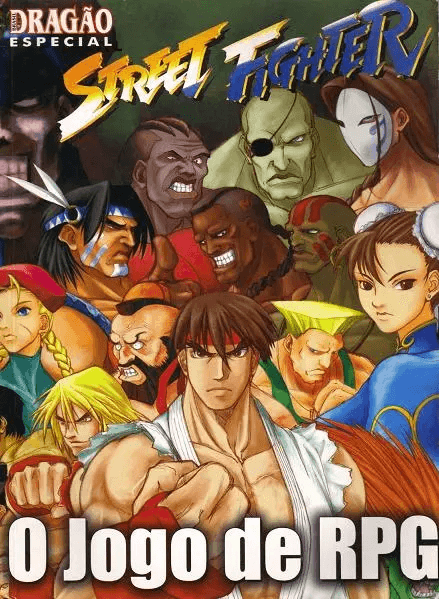
Street Fighter: The Role-Playing Game
Get ready for a new experience in the Street Fighter universe! In "Street Fighter: The Role-Playing Game", you step into the shoes of iconic warriors such as Ryu, Guile or Blanka, or you can create your own personalized fighter, developing unique special abilities and powers. Explore vibrant and challenging scenarios as you engage in combat against the evil forces of Shadoloo, led by the fearsome M. Bison. The game offers a deep immersion into the world of martial arts, mixing intense action with RPG elements. Venture to exotic locations, face champions from different countries and experience a narrative that combines strategy and emotion. Build your legend, overcome challenges and prove that you are worthy of the title of World Warrior. Get ready to fight and excel in this exciting challenge!Artists: John Bridges; Darryl Elliott
Designers: Bill Bridges; Phil Brucato
Date: 1994
Note: 6.4 [https://ludopedia.com.br/ranking?tipo=rpg]
Mechanics: Storytelling, Paper and pen, Data Scrolling, RPG
Topics: Adventure, Fighting / Martial Arts, Video Game Theme
Table of Contents
- How to Play
- Tips for playing
- Game mechanics
- Game components
- Additional Information
How to play Street Fighter: The Role-Playing Game
Create a character using the attribute and skill system in the rulebook, choosing fighting styles such as Karate, Judo or Boxing. Assign points to attributes such as Strength, Dexterity and Stamina to define your fighter's physical capabilities.
Develop unique skills by choosing special maneuvers, such as Hadouken or Shoryuken, which are crucial to standing out in combat. Customize the list of special moves to reflect your character's unique style.
Take part in narrative combats, where you describe your fighter's actions while the Game Master narrates the opponents' reactions and the course of the fight. Attacks and defenses are resolved by rolling dice and comparing them to the characters' attributes and skills.
Gain experience by winning fights to evolve your character, allowing you to improve your attributes and acquire new maneuvers, becoming more powerful and diverse in combat.
Main objective
The main objective of the game "Street Fighter: The RPG Game" is to allow players to create and customize their own fighters within the Street Fighter universe, participating in martial arts tournaments while developing their skills and advancing in the proposed narrative. Players use a system of rules that simulates the combat typical of videogames, adapted to the dynamics of a tabletop RPG, seeking to defeat opponents in strategic combats and explore the game world, interacting with iconic characters from the franchise.Tips for playing Street Fighter: The Role-Playing Game
Here are some tips for doing better in the game Street Fighter: The Role-Playing Game:
- Explore different fighting styles to find the one that best suits your character.
- Invest experience points in skills that complement your playing style.
- Pay attention to your opponents' weaknesses and resistance in order to develop effective strategies.
- Use the environment to your advantage during fights, looking for opportunities for cover and position advantage.
- Communicate with other players to form alliances and obtain valuable information.
- Try different combinations of special attacks to maximize your damage.
- Review your character's attributes frequently and adjust as necessary.
- Maintain a balance between attack and defense to ensure survival in tough fights.
- Consider using defensive techniques to thwart the attacks of more aggressive opponents.
- Be strategic in choosing when to enter combat and when to retreat to fight another day.
Video about the game
Mechanics of Street Fighter: The Role-Playing Game
- Storytelling - Central to the gaming experience, storytelling is led by the Narrator, who sets the scene and the progression of the adventure. He describes the environment, the non-playable characters and the situations the players face. The Narrator maintains the flow of the game, poses challenges and adjusts the difficulty to ensure an engaging experience.
- Paper and pen - Traditional elements in role-playing games, used to write down important information about characters, their abilities, health and progress in the story. These notes help players keep track of important details in the game, such as their statistics, equipment acquired and the development of the plot.
- Data Scrolling - It serves to determine the results of actions taken by players in the game. Multi-sided dice (often D6, D10 or D20) are rolled to resolve combats, skill tests and other random events within the game. The results of the dice are compared to a results table or to the difficulty level presented by the Narrator to decide the success or failure of an action.
- RPG - "Street Fighter: The RPG Game" adapts the traditional RPG format, allowing players to play characters within the Street Fighter universe. Each player takes on the role of a fighter with specific skills and fighting style. Players use these skills in the context of fights and narrative interactions, exploring the fictional world and progressing in the story through their choices.
Game components Street Fighter: The Role-Playing Game
See all the items in the game below Street Fighter: The Role-Playing Game:
- Special Attacks
- Passive Skills
- Playable characters
- Combat Mechanics
- Missions and challenges
- Level system
- User Interface
- Equipment and items
- Game modes
- Soundtracks and Sound Effects
Additional Information
- Ludopedia link: https://ludopedia.com.br/jogo/street-fighter-the-storytelling-game
- Link Tabletopia:
- Amazon Brazil link: Comprar Street Fighter: O Jogo de RPG
- Amazon USA link: Comprar Street Fighter: O Jogo de RPG